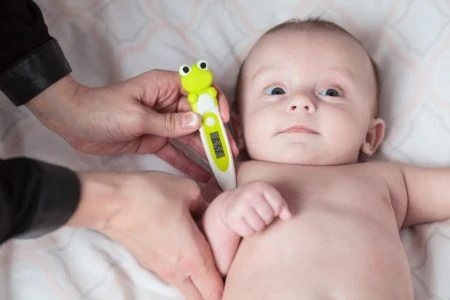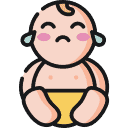While you cannot cure a cold, you can manage the symptoms to help your baby eat and sleep better (1). We will guide you through exactly how to make and administer saline drops with confidence.
Below, we share a pediatrician-approved recipe for homemade saline, step-by-step instructions for squirmy babies, and safety tips to avoid irritation.
Key Takeaways
- Mechanism: Saline drops relieve congestion by thinning mucus and reducing inflammation in the nasal membranes.
- DIY Recipe: You can make safe drops at home using 1 cup of distilled water and 0.5 teaspoon of non-iodized salt.
- Application: Lay the baby back, apply 2 drops per nostril, wait 60 seconds, and suction with a bulb syringe.
- Safety: Always use sterilized tools and discard homemade solutions after 24 hours to prevent bacterial growth.
What Are Saline Nose Drops?
Saline is simply a saltwater solution designed to mimic the body’s natural fluids. It is used to irrigate nasal passages and reduce swelling and congestion. You can buy pre-mixed bottles at any pharmacy or make a fresh batch in your kitchen.
Congestion is a common symptom of the common cold, allergies, or dry air. Because newborns are “obligate nose breathers” (they cannot breathe comfortably through their mouths), a stuffy nose can make feeding and sleeping difficult (2).
Why Are They Used for Babies?
Most over-the-counter cold medications are not safe for infants and toddlers. Saline drops are the top recommended alternative because they are drug-free.
The salt in the solution works through osmosis. It draws fluid out of swollen mucous membranes to open the airway. Simultaneously, the water adds moisture to dry, crusty mucus, turning it into a liquid that is easier to suction out.
Pediatricians recommend these drops because they are gentle, effective, and non-habit forming. You can use them repeatedly throughout the day without worrying about overdosing.
When to See a Doctor
While saline treats common congestion, some symptoms indicate a more serious infection requiring medical attention. If you notice the following signs, contact your pediatrician:
- Ear Discomfort: If your baby is tugging at their ears or crying while lying flat, they may have an ear infection (3).
- High Fever: A temperature above 100.4 F (38 C) in newborns or 102.2 F (39 C) in older babies usually warrants a call to the doctor (4).
- Thick or Colored Discharge: Clear runny noses are normal. Thick, green, or yellow sludge often indicates a bacterial sinus infection.
- Breathing Difficulties: If you see chest retractions (skin sucking in at the ribs) or flaring nostrils, seek immediate help.
If congestion lingers for more than 10 days without improvement, it may be due to allergies rather than a cold.
How to Make Saline Nose Drops at Home
You do not need to run to the pharmacy in the middle of the night. You likely have everything you need to make a safe saline solution right now (5).
Accuracy is important here. Too much salt can sting, and too little won’t work effectively. Use the following ratio:
- The Salt: 1/2 teaspoon (2.5 grams) of non-iodized salt (like pure canning or kosher salt). Do not use table salt with iodine or anti-caking agents, as these irritate sensitive noses.
- The Water: 1 cup (8 ounces) of distilled or sterilized water. If using tap water, boil it for at least one minute and let it cool to room temperature.
Mix the salt into the warm water until completely dissolved. Store this in a clean, covered glass jar.
Important Safety Note
Bacteria can grow quickly in homemade solutions because they lack preservatives. Discard any unused homemade saline after 24 hours and make a fresh batch if symptoms persist.
How to Give Saline Nose Drops to Your Baby
Administering drops to a wiggling baby can be tricky. Preparation is key to getting it done quickly and calmly.
Follow these steps for the best results:
- Prep the Tool: Draw some solution into a sterilized eyedropper or syringe.
- Position the Baby: Lay your baby on their back. Place a rolled-up towel under their shoulders to tilt their head back slightly. This helps gravity pull the saline into the nasal cavity.
- Apply Drops: Gently insert the dropper just inside the nostril (do not go deep) and squeeze 1 to 2 drops. Repeat on the other side.
- Wait: This is the most important step. Keep your baby reclined for 30 to 60 seconds. This gives the saline time to break down the mucus (loosen congestion).
- Suction: Squeeze the air out of an aspirator bulb before inserting it. Place the tip gently against the nostril to create a seal, then slowly release the bulb to suck out the mucus.
Try to do this about 15 minutes before a feeding. This clears the nose so your baby can breathe while nursing or taking a bottle.
Safety Precautions
To prevent spreading infection or causing injury, keep these safety tips in mind:
- Sanitize Equipment: Wash the dropper and bulb syringe with hot, soapy water after every single use. Rinse well and let them air dry.
- Watch for Reaction: If your baby coughs or gags, sit them upright immediately and gently pat their back.
- Don’t Over-Suction: While saline is safe to use often, using the suction bulb too frequently can inflame the nose. Limit suctioning to 3 or 4 times a day.
Additional Tips for Congestion
Saline drops work best when combined with other soothing techniques. Try these methods to help your baby breathe easier:
- Humidifiers: Run a cool mist humidifier in the nursery to keep nasal passages moist.
- Protective Barrier: Frequent wiping can irritate the skin. Dab a little petroleum jelly under the nose to prevent chapping.
- Steam Bath: Sit in the bathroom with the hot shower running (door closed) for 10 minutes. The steam acts like a natural decongestant.
- Hydration: Offer breast milk or formula frequently. Proper hydration thins mucus naturally.
Helping your sick child is stressful, but these simple tools make a massive difference in their comfort (6).












